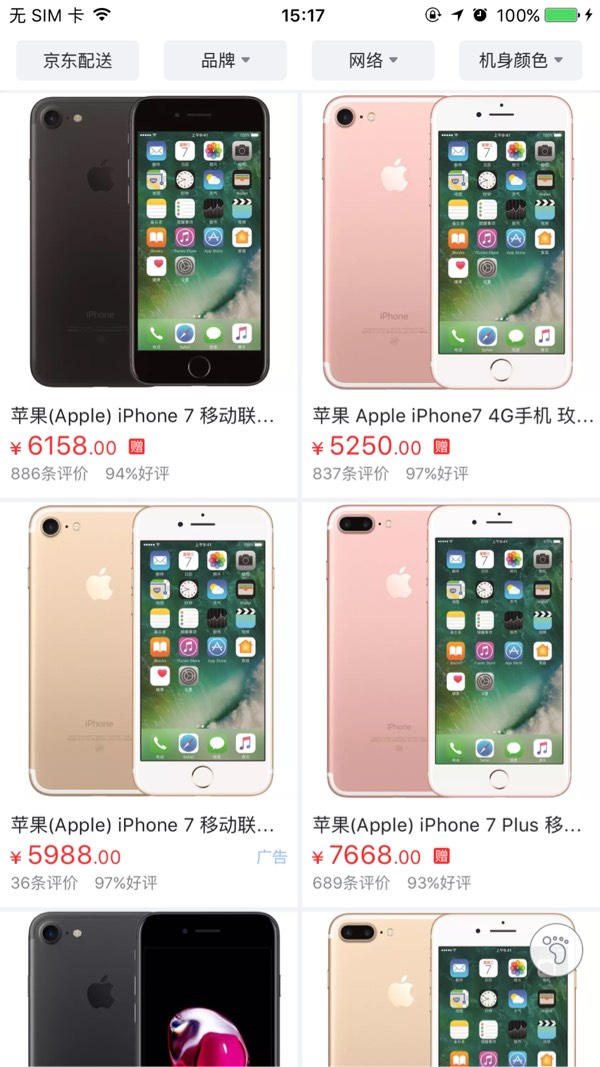下图为京东商城的截图
很多人看到这个,第一眼想到的是用tableview和collectionview来做切换,笔者刚开始也是认为这么做,后来发现还有一个非常的简单方法,就可以实现这个功能。
实现代码
1、首先创建一个collectionview。
?
|
1
2
3
4
5
6
7
8
9
10
11
12
13
14
15
16
17
18
19
20
21
22
|
- (uicollectionview *)collectionview
{
if (!_collectionview)
{
uicollectionviewflowlayout *flowlayout = [[uicollectionviewflowlayout alloc] init];
//设置滚动方向
[flowlayout setscrolldirection:uicollectionviewscrolldirectionvertical];
//左右间距
flowlayout.minimuminteritemspacing = 2;
//上下间距
flowlayout.minimumlinespacing = 2;
_collectionview = [[uicollectionview alloc] initwithframe:cgrectmake(2 , 2 , self.view.bounds.size.width - 4, self.view.bounds.size.height - 4) collectionviewlayout:flowlayout];
_collectionview.delegate = self;
_collectionview.datasource = self;
_collectionview.showsverticalscrollindicator = no;
_collectionview.showshorizontalscrollindicator = no;
[_collectionview setbackgroundcolor:[uicolor clearcolor]];
//注册cell
[_collectionview registerclass:[gridlistcollectionviewcell class] forcellwithreuseidentifier:kcellidentifier_collectionviewcell];
}
return _collectionview;
}
|
然后去京东商城抓取json数据,再去解析数据装入模型,objectwithdictionary:是将字典转化为模型,这个工具是我用 runtime 写的,一行代码解析数据。
?
|
1
2
3
4
5
6
7
8
9
10
11
12
13
14
15
16
17
18
19
|
- (void)viewdidload
{
[super viewdidload];
// do any additional setup after loading the view, typically from a nib.
// 默认列表视图
_isgrid = no;
nsstring *path = [[nsbundle mainbundle] pathforresource:@"product" oftype:@"json"];
nsdata *data = [nsdata datawithcontentsoffile:path];
nsdictionary *dict = [nsjsonserialization jsonobjectwithdata:data options:nsjsonreadingallowfragments error:nil];
[self.view addsubview:self.collectionview];
nsarray *products = dict[@"wareinfo"];
for (id obj in products) {
[self.datasource addobject:[gridlistmodel objectwithdictionary:obj]];
}
}
|
再去自定义collectionviewcell,给cell添加一个属性isgrid,用来判断是列表还是格子视图。
.h文件:
?
|
1
2
3
4
5
6
7
8
9
10
11
12
13
14
15
16
|
#import <uikit/uikit.h>
#define kcellidentifier_collectionviewcell @"gridlistcollectionviewcell"
@class gridlistmodel;
@interface gridlistcollectionviewcell : uicollectionviewcell
/**
0:列表视图,1:格子视图
*/
@property (nonatomic, assign) bool isgrid;
@property (nonatomic, strong) gridlistmodel *model;
@end
|
.m文件
?
|
1
2
3
4
5
6
7
8
9
10
11
12
13
14
15
16
17
18
19
20
21
22
23
24
25
26
27
28
29
30
31
32
33
34
35
36
37
38
39
40
41
42
43
44
45
46
47
48
49
50
51
52
53
54
55
56
57
58
59
60
61
62
63
64
65
66
|
#import "gridlistcollectionviewcell.h"
#import "gridlistmodel.h"
#import "uiimageview+webcache.h"
#define screenwidth ([uiscreen mainscreen].bounds.size.width)
@interface gridlistcollectionviewcell ()
@property (nonatomic, strong) uiimageview *imagev;
@property (nonatomic, strong) uilabel *titlelabel;
@property (nonatomic, strong) uilabel *pricelabel;
@end
@implementation gridlistcollectionviewcell
- (instancetype)initwithframe:(cgrect)frame
{
self = [super initwithframe:frame];
if (self) {
[self configureui];
}
return self;
}
- (void)configureui
{
_imagev = [[uiimageview alloc] initwithframe:cgrectzero];
[self.contentview addsubview:_imagev];
_titlelabel = [[uilabel alloc] initwithframe:cgrectzero];
_titlelabel.numberoflines = 0;
_titlelabel.font = [uifont boldsystemfontofsize:14];
[self.contentview addsubview:_titlelabel];
_pricelabel = [[uilabel alloc] initwithframe:cgrectzero];
_pricelabel.textcolor = [uicolor redcolor];
_pricelabel.font = [uifont systemfontofsize:16];
[self.contentview addsubview:_pricelabel];
}
- (void)setisgrid:(bool)isgrid
{
_isgrid = isgrid;
if (isgrid) {
_imagev.frame = cgrectmake(5, 5, self.bounds.size.width - 60, self.bounds.size.width - 60);
_titlelabel.frame = cgrectmake(5, self.bounds.size.width - 45, screenwidth/2, 20);
_pricelabel.frame = cgrectmake(5, self.bounds.size.width - 20, screenwidth/2, 20);
} else {
_imagev.frame = cgrectmake(5, 5, self.bounds.size.height - 10, self.bounds.size.height - 10);
_titlelabel.frame = cgrectmake(self.bounds.size.height + 10, 0, screenwidth/2, self.bounds.size.height - 20);;
_pricelabel.frame = cgrectmake(self.bounds.size.height + 10, self.bounds.size.height - 30, screenwidth/2, 20);;
}
}
- (void)setmodel:(gridlistmodel *)model
{
_model = model;
[_imagev sd_setimagewithurl:[nsurl urlwithstring:model.imageurl]];
_titlelabel.text = model.wname;
_pricelabel.text = [nsstring stringwithformat:@"¥%.2f",model.jdprice];
}
@end
|
再添加一个切换视图的按钮,按钮的点击事件如下:
?
|
1
2
3
4
5
6
7
8
9
10
11
12
13
|
#pragma mark - action
- (ibaction)onbtnclick:(id)sender
{
_isgrid = !_isgrid;
[self.collectionview reloaddata];
if (_isgrid) {
[self.swithbtn setimage:[uiimage imagenamed:@"product_list_grid_btn"] forstate:0];
} else {
[self.swithbtn setimage:[uiimage imagenamed:@"product_list_list_btn"] forstate:0];
}
}
|
最后还要设置一下切换时的collectionview的itemsize。
?
|
1
2
3
4
5
6
7
8
|
- (cgsize)collectionview:(uicollectionview *)collectionview layout:(uicollectionviewlayout *)collectionviewlayout sizeforitematindexpath:(nsindexpath *)indexpath
{
if (_isgrid) {
return cgsizemake((screenwidth - 6) / 2, (screenwidth - 6) / 2 + 40);
} else {
return cgsizemake(screenwidth - 4, (screenwidth - 6) / 4 + 20);
}
}
|
这样子就大体实现了列表视图和网格视图的相互切换,是不是很简单。
总结
以上就是这篇文章的全部内容了,可能由于笔者水平有限,文中如果有错误的地方,还望大家能够指出。或者有更好的方法和建议,我们也可以一起交流。希望这篇文章的内容对大家能有所帮助。
相关文章
猜你喜欢
- ASP.NET本地开发时常见的配置错误及解决方法? 2025-06-10
- ASP.NET自助建站系统的数据库备份与恢复操作指南 2025-06-10
- 个人网站服务器域名解析设置指南:从购买到绑定全流程 2025-06-10
- 个人网站搭建:如何挑选具有弹性扩展能力的服务器? 2025-06-10
- 个人服务器网站搭建:如何选择适合自己的建站程序或框架? 2025-06-10
TA的动态
- 2025-07-10 怎样使用阿里云的安全工具进行服务器漏洞扫描和修复?
- 2025-07-10 怎样使用命令行工具优化Linux云服务器的Ping性能?
- 2025-07-10 怎样使用Xshell连接华为云服务器,实现高效远程管理?
- 2025-07-10 怎样利用云服务器D盘搭建稳定、高效的网站托管环境?
- 2025-07-10 怎样使用阿里云的安全组功能来增强服务器防火墙的安全性?
快网idc优惠网
QQ交流群
您的支持,是我们最大的动力!
热门文章
-
2025-06-04 35
-
2025-05-25 41
-
2025-05-27 15
-
2025-05-25 33
-
2025-06-04 21
热门评论














